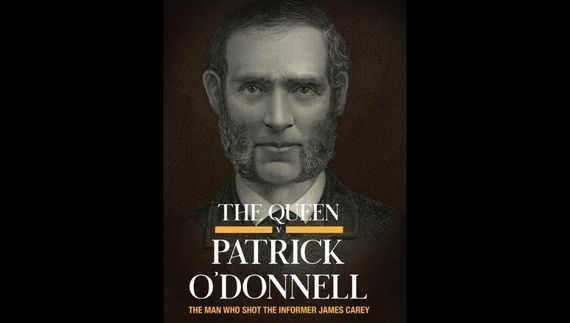
The Queen v Patrick O'DonnellGetty: Images
The Queen v Patrick O’Donnell (The man who shot the informer James Carey) is a new book set to be published on July 9th, 2021
The Queen v Patrick O'Donnell reveals for the first time the full story behind one of the most compelling murder stories in Irish history, a thrilling tale of violence, courtroom drama, romance and political intrigue. Containing evidence from British Home Office files kept secret for 100 years, this account reveals shocking new information about the fate of Patrick O’Donnell.
The subject of a famous Ballad (the Ballad of Patrick O’Donnell) and with his own verse in The Monto, Patrick O’Donnell achieved the status of a national hero when he killed Ireland’s most infamous informer James Carey on board a steamship off the coast of South Africa in 1883.
Read more
Why did the quiet-spoken laborer from the Donegal Gaeltacht shoot the leading Fenian in the Phoenix Park murders? And why did the President of the United States of America and the French writer Victor Hugo plead that Patrick O’Donnell not be hanged for his crime?
When Lord Frederick Cavendish and Thomas Burke were killed by the Invincibles in the Phoenix Park in May 1882, nothing like it had ever happened before in British political life [the Phoenix Park murders of May 6th, 1882 were called the "9/11" of their day by Deaglán de Bréadún in the Irish Times in 2006]. The double assassination was politically motivated and was particularly gruesome—long surgical knives were the assassins’ chosen instruments—and this aspect greatly appealed to the instinct of the popular press for sensationalism, which was then coming to the fore and the case spawned acres of newspaper coverage.
The outrage that the killing caused amongst the political élite in Britain and the horror it engendered in the British public generally were both writ large within 10 Downing Street. The news of the murders spread like wildfire through Ireland, England, Europe and America and the British Government acted immediately to attempt to bring the culprits to task for their heinous crime. Superintendent John Mallon (born 1839) of the Dublin Metropolitan Police. Shrewdly intelligent, Mallon, was a Catholic from Co. Armagh. Mallon’s ‘G’ division was a unit of plainclothes detectives who were often tasked with spying, recruitment of informers, prevention of political violence and apprehension of Irish republican political subversives in the 19th century.
His league of spies and informers quickly identified the main suspects and it was while being held in Kilmainham Jail, that Mallon persuaded, one of these men, James Carey, to turn informant on his fellow assassins. Five of these betrayed men, members of a secret society called the Invincibles, were hanged for the crime in 1883.
For Irish Nationalists and Republicans, and for a huge number of the population in general, an informer was the lowest of the low, and in fact, was often reviled even more than the original enemy. On given an opportunity to speak in court following being sentenced to death, Daniel Curley, one of the leaders of the Invincibles, stood up and said “if I had a thousand lives to lose, I would lose them sooner than bring to my grave the name of an informer, and that I should save my life by betraying my fellow man”. These words only compounded the hatred that people now felt for James Carey and Superintendent John Mallon quickly arranged for Carey and his seven children to be sent out of Ireland. The problem was to find a safe haven in the English-speaking parts of the world; the USA and Canada, the Australian colonies and New Zealand, even the Cape Colony had too many Fenian sympathizers in them for safety. So the Province of Natal in South Africa was chosen, where the Irish were thin on the ground.
Traveling on the same ship was another Irishman called Patrick O’Donnell, a man in his mid-forties, illiterate but respectable both in appearance and conduct who was born in the Gweedore district of Donegal in 1838. He was not a Fenian and was never involved in any political activity. O’Donnell and Carey became friendly during the crossing but at about a quarter to four on Sunday 29th July when O’Donnell and Carey were having a drink together in the saloon O’Donnell drew a revolver and shot his friend three times.
Patrick O’Donnell shot James Carey dead on the voyage, there was no doubt to that but (1) How, did O’Donnell come to shoot Carey and (2) Why did he shoot him? These were the important questions that followed O’Donnell to his trial in 1883 at the Old Bailey presided over by Judge George Denman. O’Donnell claimed Self-defence and although there did seem to be evidence to support this claim, he was found guilty, and on 17th December 1883, Patrick O’Donnell was hanged for the murder of James Carey.
The Queen v Patrick O’Donnell (The man who shot the informer James Carey) will be published on July 9th 2021





Comments